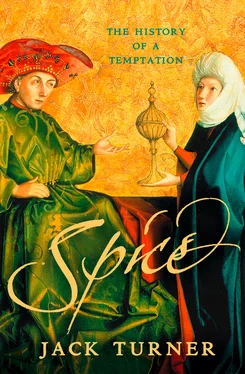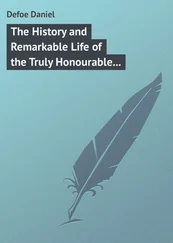Of course ‘spice’ suggests much more than veiled erotic allusion. Besides romance, if that is the word, there are the Romantics, for whom spices are inextricably linked with images of a fabulous Orient in all its mystery and splendour. The word comes poetically charged, In A Midsummer Night’s Dream Titania tells Oberon of her conversation with a changeling’s mother in the ‘spiced Indian air’; in the dour surrounds of a New England farmhouse, Herman Melville imagined the ‘spiced groves of ceaseless verdure’ growing on the enchanted islands of the East. For countless others spices and the spice trade have evoked a host of vague, alluring images: dhows wafting across tropical seas, the shadowy recesses of Eastern bazaars, Arabian caravans snaking across the desert, the sensual aromas of the harem, the perfumed banquets of the Moghul’s court. Walt Whitman looked west from California to ‘flowery peninsulas and the spice islands’ of the East; Marlowe wrote of ‘Mine argosie from Alexandria, Loaden with spice and silks, now under sail … smoothly gliding down by Candy shore’. In a similar vein Tennyson waxed lyrical on the ‘boundless east’ where ‘those long swells of breaker sweep/The nutmeg rocks and isles of clove’. Spices and the trade that brought them have long been one of the stocks-in-trade of what Edward Said labelled the Orientalist imagination, their reputation for the picturesque, glamour, romance and swashbuckle enduring from the tales of Sinbad to several recent (often equally fabulous) non-fiction potboilers. We can still appreciate the nostalgia of Masefield’s poem ‘Cargoes’, with its
Stately Spanish galleon coming from the Isthmus,
Dipping through the Tropics by the palm-green shores .
With a cargo of diamonds ,
Emeralds, amethysts ,
Topazes, and cinnamon, and gold moidores.
All of which was a world away from the ‘Dirty British coaster’ laden with ‘Tyne coal’ and ‘cheap tin trays’ of Masefield’s day.
Or, for that matter, our own day. Much of spices’ own cargo is still with us, for they continue to evoke something more than mere seasonings, a residual verbal piquancy that is itself the echo of a past of astonishing richness and consequence. By the time these quintessentially Eastern products reached the West, spices had acquired a history laden with meaning, in which respect they are comparable to a mere handful of other foods, the weight and richness of their baggage rivalled only by bread (‘give us this day our daily bread’), salt (‘the salt of the earth’) and wine (‘in wine is truth’ – but also the liquor of death, life, deceit, excess, the mocker or mirror of man). Yet the symbolism spices have carried is more diverse, more spiked with ambivalence than these parallels would suggest. When spices arrived by ship or caravan from the East, they brought their own invisible cargo, a bulging bag of associations, myth and fantasy, a cargo that to some was as repulsive as others found it attractive. For thousands of years spices have carried a whole swathe of potent messages, for which they have been both loved and loathed.
To explain why this is so, how spices came to acquire this freight, is the purpose of this book. Contrary to the certainties of my faraway classroom, this was not an appetite amenable to a simple explanation: there was a good deal more to the attraction of spices than culinary expediency, nor, for that matter, was the food of the Middle Ages quite so bad as moderns have generally been willing to believe. This is a diverse and sprawling history spanning several millennia, beginning with a handful of cloves found in a charred ceramic vessel beneath the Syrian desert where, in a small town on the banks of the Euphrates, an individual by the name of Puzurum lost his house to a devastating fire. In cosmic terms, this was a minor event: a new house was built over the ruins of the old, and then another, and many others after that; life went on, and on, and on. In due course a team of archaeologists came to the dusty village that now stands atop the ruins where, from the packed and burned earth that had once been Puzurum’s home, they extracted an archive of inscribed clay tablets. By a happy accident (for the archaeologists, if not for Puzurum), the blaze that destroyed the house had fired the friable clay tablets as hard as though they had been baked in a kiln, thereby ensuring their survival over thousands of years. A second fluke was a reference on one of the tablets to a local ruler known from other sources, one King Yadihk-Abu. His name dates the blaze, and the cloves, to within a few years of 1721 BC.
As startling as the mere fact of the cloves’ survival might seem, what makes the find truly astonishing is a botanical oddity. Prior to modern times, the clove grew on five tiny volcanic islands in the far east of what is today the Indonesian archipelago, the largest of which measures barely ten miles across. Because cloves grew nowhere else but on Temate, Tidore, Moti, Makian and Bacan, these five islands, collectively the Moluccas, were household names of the sixteenth century, spoils contested by rival empires over half a world away. Cervantes found in the rivalry between Ternate and Tidore a suitably exotic setting for his novel The History of Ruis Dias, and Quixaire, Princess of the Moluccas. And yet as colourful as the Moluccas seemed to a sixteenth-century readership, in Puzurum’s day they were surely beyond even the reach of fantasy. For this was an age when Mesopotamian scribes etched their cuneiform narrations of the hero Gilgamesh, when the wild man Humbaba stalked the cedar forests of Lebanon, when genii and lion-men roamed the lands over the horizon. Many centuries before compasses, maps and iron, when the world was an inconceivably more vast and mysterious place than it has since become, cloves came from the smoking, tropical cones of the Moluccas to the parched desert of Syria. How this occurred, who brought them, is anyone’s guess.
Since the incineration of Puzurum’s cloves there have been many more famous spice-seekers sprinkled through history. There are the names we learned at school: Christopher Columbus, Vasco da Gama and Ferdinand Magellan, gambling with scurvy, shipwreck, sheer distance and ignorance to find the ‘places where the spices grow’ – with spectacularly mixed results. There were, besides, the colossal, heroic failures: Samuel de Champlain and Henry Hudson hunted in vain for nutmeg in the snowy wastes of Canada; the Pilgrim Fathers scoured the cold Plymouth thicket; others froze among the bergs of Novaya Zemlya or left their bones bleaching on some forgotten shore, an entire hemisphere short of their objective.
The story of their spice odysseys have filled plenty of books already. The pages that follow do not pursue the twists and turns of the spice routes, nor the (generally sorry) fates of the traders who travelled them. This book is not a history of the spice trade, at least not in a conventional, narrative sense. I have not sought to retrace the winding pathways that brought cloves to Puzurum or nutmeg to the king of Spain, least of all to show how spices ‘changed the world’. (All writers and publishers who embrace this view too avidly would be well advised to read Carlo Cipolla’s hilarious, acid parody, Le poivre, moteur de l’histoire [Pepper, Motor of History].) In fact I am less concerned with the thorny questions of causation, how spices shaped history, than with how the world has changed around them: why spices were so appealing; how that appeal emerged, evolved and faded. In focusing on the appetite that the spice trade fed, this is not so much a study of the trade as a look at the reasons why it existed.
These reasons were more diverse than we might at first suppose. Taste was only one of the many attractions of spices; they bore many exotic flavours, not all of them to be enjoyed at the table – or even, for that matter, enjoyed. Intertwined in their long culinary history there is another older still, one that until recent times was seldom far from the minds of their consumers. Besides adding flavour to a dry and salty piece of beef or relieving the fishy tedium of Lent, spices were put to such diverse purposes as summoning gods and dispelling demons, driving off illness or guarding against pestilence, rekindling waning desire or, in the words of one authority, making a small penis splendid – a claim that would gratify the creative talents behind the Spice channel. They were medicines of unrivalled reputation, metaphors for the faithful and the seeds of purportedly volcanic erotic enhancement.
Читать дальше











